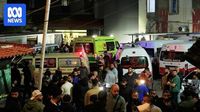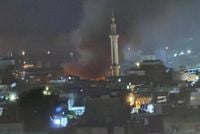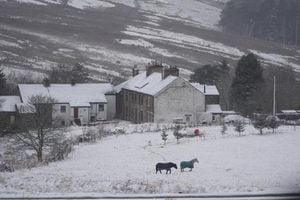In a development that has sent shockwaves across the Middle East, an Israeli air strike on Tuesday, November 18, 2025, targeted the Ein el-Hilweh Palestinian refugee camp on the outskirts of Sidon, a coastal city in southern Lebanon. According to the Lebanese Health Ministry, the attack killed 13 people and wounded several others, marking the deadliest single strike on Lebanese territory since the ceasefire that ended the Israel-Hezbollah war a year ago. The drone strike, which hit a car parked near the Khalid bin al-Walid mosque within the camp, triggered chaos, with ambulances rushing to evacuate the injured and retrieve the dead while journalists were barred from accessing the scene by local Hamas fighters, as reported by the state-run National News Agency and multiple international outlets including the Associated Press and France 24.
The Israeli military swiftly claimed responsibility for the strike, stating that it had targeted what it described as a Hamas training compound. In an official statement, the Israeli Defense Forces asserted, “The IDF struck terrorists who operated in a Hamas training compound in the Ain al-Helweh area in southern Lebanon,” further emphasizing their ongoing campaign to “act against Hamas wherever the group operates.” Israeli officials contended that the compound was being used by Hamas operatives to prepare attacks against Israel and its army, underlining a broader strategy to disrupt the group’s activities beyond Gaza’s borders. According to reporting by South China Morning Post and France 24, the Israeli army made clear its intent to continue similar operations as long as it deems necessary.
However, the narrative from the Palestinian side tells a very different story. Hamas, in a strongly worded statement, condemned the attack and categorically denied the presence of any military installations in the refugee camp. “The claims and allegations of the Zionist occupation army that the targeted location is a ‘training compound belonging to the movement’ are pure fabrication and lies, aimed at justifying its criminal aggression,” the group declared. Hamas insisted that the strike hit an open sports playground used by residents, not a military site, and maintained that there are no military establishments within Palestinian camps in Lebanon. This assertion was echoed by local sources and reported by The Palestine Chronicle and The Hindu, who highlighted the civilian toll and the destruction wrought in the camp’s lower streets, where fires broke out following the attack.
The Ein el-Hilweh camp, long a symbol of the Palestinian diaspora in Lebanon, has found itself at the center of regional tensions for decades. Tuesday’s strike, which also reportedly damaged the mosque and a community center bearing the same name, has reignited fears among the camp’s residents and the broader Lebanese public about the fragility of the current ceasefire. The Lebanese Health Ministry’s confirmation of the 13 fatalities and multiple injuries underscores the human cost of the renewed hostilities, while the ongoing evacuation and medical response hint at the possibility that the casualty count could rise.
Tuesday’s events did not occur in isolation. Earlier the same day, Israeli drone strikes in other parts of southern Lebanon, including the towns of Blida and Bint Jbeil, killed at least two people, according to local media and the Ministry of Public Health. These attacks, combined with low-flying Israeli drones and warplanes conducting simulated raids over Lebanese airspace, have contributed to a growing sense of insecurity along the border. The National News Agency reported that the outskirts of Hula and Markaba were also subjected to Israeli gunfire from a newly established military post, further highlighting the tense atmosphere that prevails in the region.
The strike on Ein el-Hilweh is the latest in a series of Israeli operations in Lebanon since the end of the full-scale war with Hezbollah in November 2024. That conflict, sparked by the October 7, 2023, Hamas-led attack on southern Israel—which killed about 1,200 people—quickly escalated into a regional conflagration. Israel’s subsequent offensive in Gaza has, according to the Gaza Health Ministry, resulted in the deaths of tens of thousands of Palestinians, the majority of whom are women and children. The war with Hezbollah, which erupted in late September 2024 and lasted for two months, left more than 4,000 dead in Lebanon and 127 in Israel, with the World Bank estimating the damage in Lebanon at $11 billion.
Despite the US-brokered ceasefire signed on November 27, 2024, hostilities have continued at a lower intensity. Israel justifies its ongoing strikes by citing the need to prevent Hezbollah and Hamas from rebuilding their military capabilities in southern Lebanon. Lebanese authorities, however, accuse Israel of violating the ceasefire terms, particularly as Israeli forces continue to occupy five hilltops seized during the last war and maintain a presence in other longstanding disputed areas. The Lebanese Health Ministry reports that since the ceasefire, more than 270 people have been killed and about 850 wounded by Israeli military actions in Lebanon.
Tuesday’s air strike has drawn international attention not only because of its immediate death toll but also due to the broader implications for regional stability. With each side offering sharply divergent accounts—the Israeli military insisting it is targeting legitimate threats, and Palestinian and Lebanese officials decrying what they describe as attacks on civilians—the risk of renewed escalation looms large. The inability of journalists to access the site, due to restrictions imposed by Hamas fighters, has further complicated efforts to independently verify the exact circumstances and casualties of the attack.
For the residents of Ein el-Hilweh and the wider Sidon area, the events of November 18 are yet another chapter in a long history of conflict and displacement. The camp, home to tens of thousands of Palestinian refugees, has frequently found itself caught between regional power struggles and local factionalism. Tuesday’s strike, with its devastating consequences, serves as a stark reminder of the precariousness of peace in Lebanon’s south—and the potential for even localized incidents to inflame broader tensions.
As the dust settles and the wounded are treated, the world watches closely to see whether this latest tragedy will serve as a catalyst for renewed violence or a sobering reminder of the urgent need for a durable peace. For now, the people of Ein el-Hilweh mourn their dead, uncertain of what the coming days may bring.





